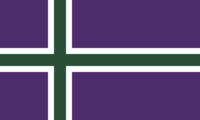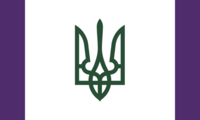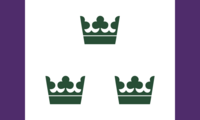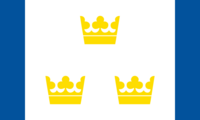Flag of Arcadia
 | |
| Name | Banderamorada (L1) Bandeiraroxa (L2) Bandieraviola (L2) |
|---|---|
| Use | National Flag |
| Proportion | 3:5 |
| Adopted | c. 13th century (original version, as a royal banner) 5 October 1961 (current version)) |
| Design | A purple field charged with a white-fimbriated dark green horizontally rotated cross that extends to the edges; the vertical part of the cross is shifted to the hoist side. |
 Variant flag of Arcadia | |
| Use | Civil Flag |
| Proportion | 3:5 |
| Adopted | 17 May 1619 (as a war flag) 3 August 1870 (as the official civil flag) |
| Design | Two vertical stripes of purple (either side) and white (middle). The white stripe is twice the size of the purple stripes. A green Arcadian Trident is in the center. |
| Designed by | Carlos II |
History
Absolutist Era (c. 1230-1764)
Officially the Arcadian flag at this point in history was a purple banner with green cross, believed to be personal battle flag of King Leon I which eventually became the national colors of the country. However, due to the expense related to the purchase of purple and green dyes, blue and gold was commonly substituted in situations where members of the Royal Family were not present. This meant that despite the purple and green being the official colors of the country, it was de facto a personal banner throughout the Absolutist Era
Constitutional Monarchy (1764-1870)
After the Absolutist War, the national flag was changed from the king's banner, as the Parliament pushed forward the first designs of Arcadian flags that included the "Trident", representing the Monarch, the Parliament, and the People as a single coherent force. The flag included many symbols of the monarchy, including the colors. Purple and green remained the official colors of the country, but blue and gold remained common for civilian use. At this time the design, though not the colors, of the modern civil flag originated. Towards the end of the Parliamentary Kingdom, purple and green began to increase in circulation due to cheaper dyes.
Republic (1870-1892)
Economic dissatisfaction and the rise of socialist movements lead to the Second Arcadian Civil War, which saw the Republican forces abolish the monarchy and nobility. The flag's symbols and colors changed to not only remove all traces of the monarchy but to abolish the traditional purple and green in favor of red, white, and blue. The First Republic of Arcadia would last 22 years, however the Republican government was ineffective and unpopular throughout most of its reign.
Resurgent Monarchy (1892-1923)
Nostalgia for the monarchy led to the Monarchist Party being formed in the 1887 elections. By 1892, the Monarchist Party formed a large portion of the Republican Congress and its support was necessary for any of the major parties to form a government. In exchange for its support, the Congress voted to rewrite the constitution and re-establish the monarchy, though a much more limited form than had existed prior, forming the Second Kingdom of Arcadia.
Early Dictatorship (1923-1949)
On 18 January, military forces under the command of Premier Secretary for Defense, Cezar Medeiros, entered Puerto Libre. Within several hours, both Prime Minister Alvaros and Queen Sofia I were executed, and the children of the royal family had fleed. Secretary Medeiros established the Medeirist dictatorship and would rule over it until his death in 1943, when he was succeeded by Angel Vasquez.
Democratization (1949-1961)
After the death of Vasquez, an extraordinary Arcadian Council of National Defense was formed.


